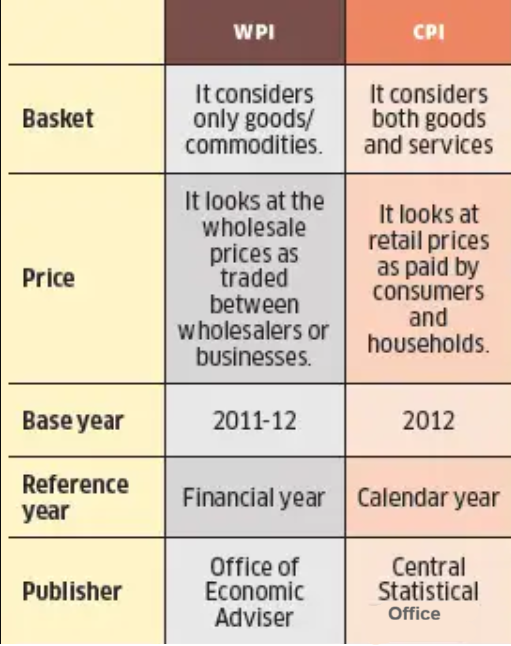Wholesale Price Index Slips Into Deflation | 17 Nov 2025
Why in News?
India’s Wholesale Price Index (Base Year: 2011–12) fell to a 27-month low in October 2025, slipping into deflation at –1.21%, compared to –0.13% in September. The drop was driven by lower prices of food items and crude petroleum, softer fuel and manufactured goods prices, and the impact of 2025 Goods and Services Tax (GST) reforms.
- Deflation is the opposite of Inflation. It refers to a sustained and general decrease in the overall price levels of goods and services in the economy.
What are the Key Facts About Wholesale Price Index?
- About WPI: WPI tracks the average change in prices at the wholesale level for a fixed basket of goods.
- The prices tracked are ex- factory price for manufactured products, agri-market (mandi) price for agricultural commodities and ex-mines prices for minerals.
- Weights given to each commodity covered in the WPI basket is based on the value of production adjusted for net imports. WPI basket does not cover services.
- Composition of WPI Basket: It covers commodities falling under the three Major Groups namely Primary Articles, Fuel and Power and Manufactured products.
- Primary Articles (Base Year: 2011–12): Includes food articles, non-food articles, minerals, and crude petroleum and natural gas.
- Primary Articles hold the second-highest weight (22.62) in the WPI basket.
- Fuel and Power (Base Year: 2011–12): Covers coal, mineral oils, and electricity.
- Fuel and Power have the lowest weight (13.15) in the WPI basket.
- Manufactured Products (Base Year: 2011–12): Comprises 22 industrial sub-groups.
- Manufactured Products carry the highest weight (64.23) in the WPI basket.
- The WPI Food Index (weight 24.38) tracks price changes of food items at the producer level. It consists of Food Articles from the Primary Articles group and Food Products from the Manufactured Products group.
- Primary Articles (Base Year: 2011–12): Includes food articles, non-food articles, minerals, and crude petroleum and natural gas.
- Compilation: Provisional monthly WPI for All Commodities is released on 14th of every month (next working day, if 14th is holiday).
- The WPI is compiled and released by the Office of the Economic Adviser under the Department for Promotion of Industry and Internal Trade, Ministry of Commerce and Industry.
- Treatment of Imports and Exports: WPI covers all transactions at the first point of bulk sale, with item weights based on domestic production plus net imports.
- The only exception is crude oil, where only domestic production is counted because imports are far larger, crude itself isn’t traded in India’s wholesale market, and its petroleum derivatives are already included under fuel and power.
- Importance of WPI: WPI helps monitor price movements across the economy and acts as a key deflator for converting nominal GDP and other variables into real values.
- It guides trade, fiscal and economic policies and is widely used in escalation clauses for long-term contracts in sectors like construction and machinery. Businesses and analysts also rely on it for price adjustments.
- Difference Between WPI and CPI: WPI captures wholesale price changes, while consumer price index (CPI) measures retail-level price changes faced by consumers.
- WPI signals early shifts in commodity prices, whereas CPI is more relevant for assessing the cost of living.
- CPI is released by the Ministry of Statistics & Programme Implementation (MoSPI), while WPI is published by the Ministry of Commerce and Industry.
Frequently Asked Questions (FAQs)
1. What does Wholesale Price Index(WPI) measure?
WPI tracks the average change in wholesale-level prices for a fixed basket of goods, covering primary articles, fuel and power, and manufactured products.
2. Who releases the WPI?
It is compiled and released monthly by the Office of the Economic Adviser, DPIIT, under the Ministry of Commerce and Industry.
3. Why is crude oil treated differently in WPI?
Only domestic production is counted because crude isn’t traded in the domestic wholesale market and its imports far exceed local output.
4. What makes WPI different from Consumer Price Index (CPI)?
WPI measures wholesale price changes, while CPI reflects retail prices and cost of living; CPI is released by MoSPI.
UPSC Civil Services Examination, Previous Year Question (PYQ)
Prelims
Q. Consider the following statements: (2020)
- The weightage of food in Consumer Price Index (CPI) is higher than that in Wholesale Price Index (WPI).
- The WPI does not capture changes in the prices of services, which CPI does.
- Reserve Bank of India has now adopted WPI as its key measure of inflation and to decide on changing the key policy rates.
Which of the statements given above is/are correct?
(a) 1 and 2 only
(b) 2 only
(c) 3 only
(d) 1, 2 and 3
Ans: (a)


